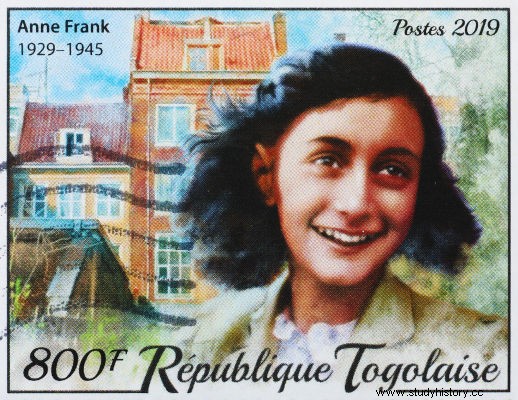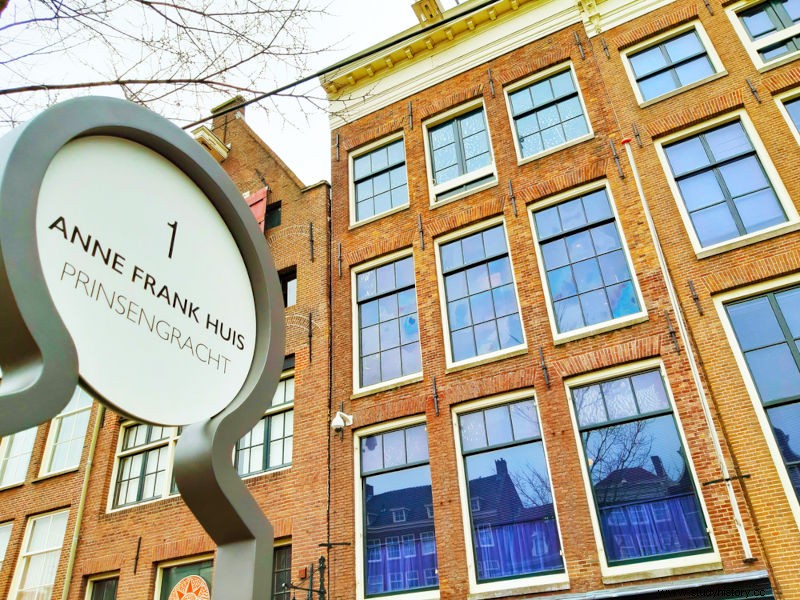Anne Frank she was a young woman from a Jewish family who became internationally known for recording her confinement in a personal diary, which later received the title:Anne Frank's Diary . She was confined with her family and four others in a building in Amsterdam. She was eventually captured and sent to Nazi concentration camps, where she died.
Go to also :Crystal Night – one of the pogroms held against Jews in Germany
Birth
Annelies Marie Frank was born on June 12, 1929 , in Frankfurt, Germany . She belonged to a family of Jews assimilated , therefore, they were Jews who had been established in Germany for generations and who had abandoned various religious practices, living with both Jews and non-Jews.

Her father's name was Otto Frank, and he supported his family with small businesses. Her mother was named Edith Holländer-Frank, and from the marriage of Edith and Otto two daughters were born:Margot, in 1926, and Anne, in 1929.
Anti-Semitism
Anne Frank was born into a scenario of great hostility to Jews. By 1929, the Nazis were already a rising party in Germany, and in 1933, Hitler was named Chancellor of the country. The arrival of the Nazis to power automatically started anti-Semitic measures. With segregation in evidence, Anne Frank's family decided to leave Germany .
Edith and her two daughters moved to Aachen, where her maternal grandmother lived, and Otto moved to Amsterdam, the Netherlands. There he started a branch of a company that sold pectin, a product used in the manufacture of jams. The company was called Opekta.
With their new job, Anne and her family have settled in Amsterdam , the youngest daughter being the last to move there, in February 1934.
In Amsterdam, Anne Frank had to get used to the new language (Dutch) and was enrolled in a school. Starting in 1938, Otto Frank started a second company in the same country, this being a company that not only sold products for jellies, but also products for making sausages. The steady life the Frank family had changed with the outbreak of WWII .
Secret attachment
On September 1, 1939, Germany invaded Poland, and this act started World War II. Soon the conflict reached the Netherlands, and, on May 10, 1940, the country was invaded. The Dutch government went into exile, and the Dutch army surrendered five days later. Once again, Anne Frank's family was under Nazi yoke.
The Nazis quickly implemented anti-Semitic measures in the Netherlands. A significant change was that Otto had to relinquish his position , as the Nazis did not allow Jews to run businesses. This was one of several restrictions imposed on Jews in the country. Among other measures were, for example, the mandatory use of a Star of David on clothing, as a form of identification, the ban on sports, the imposition of a curfew, etc.
The Anne Frank family decided they needed a run away again . The first alternative was the United States, but the family's application to receive the visa was never processed by the US Embassy. The situation was worsened by the war, as the borders of the Netherlands were closed.
The way out Otto Frank found was to hide the family where it was . He took her to a annex that was on Prinsengracht 263 , right where he worked. It turns out that this building had an annex that had its entrances covered. This location spread over the three floors of the building.
The Frank family decided that their move would take place in late July 1942, but the appointment of Margot to work in Germany made them all move on July 6, 1942 to the annex. The installation of the Frank family in this place took place with the help of some of the employees of the company where Otto worked.
Anne Frank called this hideout A nexus S secret, and her family stayed there for two years. They could not make noise during the day, as not all company employees who were in the building knew that there were Jews hiding there. The information they got came from a radio or people who helped them.
In addition to the Frank family, the secret annex received the family V an Pels , formed by Hermann, Auguste and Peter, and also Fritz Pfeffer .
Login also :How did the Nazi death squads act?
-
Anne Frank's Diary

All the suffering of the people hiding in the Secret Annex has been recorded by young Anne Frank in her diary. She got it on June 12, 1942 when she turned 13 years old , giving it a name, Kitty , and considering it a kind of imaginary friend .
The Anne Frank Diary has become one of the most significant historical documents of World War II and the Holocaust. Through him, one could get a sense of the agony that those hidden people faced as victims of Nazi anti-Semitism.
Throughout her writing, Anne Frank recorded reflections on feelings and on her relationship with her family and with the others present in the hiding place. She also talked about a possible life after the war and made several comments about the conflict.
In her record, Anne Frank showed interest in pursuing a career as a writer after the war. The diary was published in 1947, by decision of his father, in honor of its author, who, as we will see, did not survive the Holocaust. Otto Frank had access to his daughter's diary only after the conflict ended.
He returned to Amsterdam after the Nazi defeat, and there one of the people who helped him and his family during the period of hiding, Miep Gies , handed him Anne's notes. Gies had rescued young Anne's diary after the hiding place was discovered by the police.
Login also :Nuremberg Law and anti-Semitic segregation
Capture and kill
On August 4, 1944, the Secret Annex was invaded by Schutzstaffel soldiers and police . With the break-in, all eight people in hiding were arrested, taken in for questioning and then taken to a concentration camp in the Netherlands, the Westerbork camp.
To this day, historians do not know what led the police and SS soldiers to the building where the hideout was located. One theory is that the site was denounced by someone who knew of its existence or by someone who suspected that there were people hiding in it.
The other theory works with the idea that the cache was discovered by chance . This version claims that the police had gone to Prinsengracht 263 to investigate a report of fraud in the distribution of food stamps, but that, during the raid, they ended up discovering the hiding place. Regardless of what drove the officers to the scene, the fact remains that Anne Frank and her entire family were sent to Auschwitz-Birkenau.
At Auschwitz-Birkenau, people were separated for forced labor and those who were sent directly to be executed in the gas chambers. Anne, Edith and Margot were separated from Otto and sent to work slave ized . They worked hard, and the bad conditions caused Margot and Anne to get scabies.
They received limited medical treatment and the care of their mother, Edith, who gave them all the food she could get. In November 1944 Anne and Margot were sent to Bergen-Belsen, and Edith stayed in Auschwitz, dying shortly afterwards of starvation .
Anne and Margot Frank contracted typhoid fever in Bergen-Belsen, a concentration camp that was packed with people. The day on which the two died is unknown, but it is known that this occurred between February and March 1945, with Anne dying a day later than her sister. Their bodies wereburied in ditches common .
The only one in the family to survive was Otto Frank. All other members of the Secret Annex died victims of the Holocaust.
Image credits
[1] spatuletail and Shutterstock
[2] alessia_penny90 and Shutterstock
